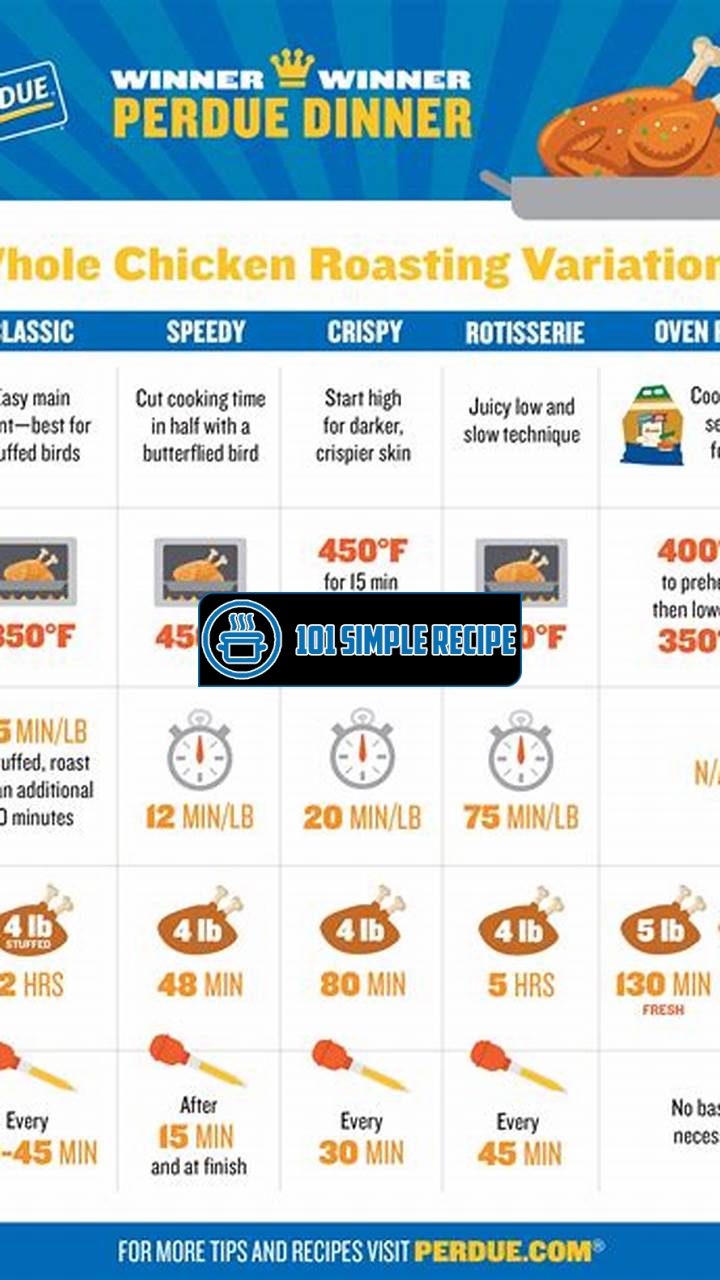Are you tired of overcooked or undercooked chicken? Look no further! In this article,

we will provide you with the ultimate guide to cooking chicken to perfection every single time. Whether you’re a seasoned cook or a beginner in the kitchen, you’ll learn the best techniques, tips, and tricks to ensure juicy, tender, and flavorful chicken that will impress even the toughest food critics. So, put on your apron and get ready to elevate your chicken dishes to a whole new level! ️
Understanding the Role of Temperature in Cooking Chicken
In the culinary world, temperature plays a crucial role when it comes to cooking chicken. Not only does it ensure the safety of the meat, but it also brings out the optimal flavor that we all crave. So, let’s dive into the importance of temperature in cooking chicken to achieve perfection every time.
The Basics: Internal Temperature Guidelines
When it comes to cooking chicken, it is essential to know the right internal temperature guidelines to ensure it is properly cooked. Undercooked chicken can pose serious health risks, such as salmonella contamination.
The recommended internal temperature for cooked chicken varies depending on the cut. For chicken breasts, it should reach an internal temperature of 165°F (74°C). Thighs, drumsticks, and wings, on the other hand, should reach a slightly higher temperature of 175°F (79°C). Using a meat thermometer is the best way to accurately determine the internal temperature of chicken.
By following these guidelines, you can ensure that your chicken is not only safe to consume but also incredibly juicy and flavorful. Cooking chicken to the right temperature allows the meat to retain its natural juices, resulting in a tender and delectable experience.
The Importance of Proper Temperature
Proper temperature is crucial not only for the safety of the meat but also for achieving the desired texture and flavor. When chicken is cooked to the appropriate temperature, it eliminates any harmful bacteria that may be present, reducing the risk of foodborne illnesses.
Additionally, cooking chicken to perfection requires the right temperature to achieve the desired texture. Overcooking can lead to dry and rubbery chicken, while undercooking can result in raw and unpleasant meat. By adhering to the recommended internal temperature guidelines, you can ensure that your chicken is succulent, tender, and bursting with flavor.
Moreover, proper temperature control is essential throughout the cooking process. Factors such as preheating the oven or grill, maintaining a consistent temperature, and allowing the chicken to rest after cooking all contribute to achieving the best results.
Factors Affecting Cooking Time
While knowing the internal temperature guidelines is crucial, it is important to understand that various factors can affect the cooking time of chicken. These factors include the thickness of the meat, the cooking method, and the starting temperature.
Thicker chicken cuts will naturally take longer to cook compared to thinner cuts. Adjusting the cooking time accordingly to ensure the chicken reaches the recommended internal temperature is vital. Additionally, the cooking method used, whether it’s baking, grilling, or sautéing, can affect the overall cooking time.
Another factor to consider is the starting temperature of the chicken. If the chicken is taken directly from the refrigerator, it will take longer to reach the desired internal temperature compared to chicken that has been brought to room temperature beforehand.
By taking these factors into account and understanding the role of temperature in cooking chicken, you can master the art of cooking chicken to perfection every time. Remember, proper temperature not only ensures safety but also brings out the succulent flavors that make chicken dishes truly remarkable.
Ranch oyster crackers recipe can be a great side dish for your chicken meal.
Using a Meat Thermometer for Accurate Results
When it comes to cooking chicken, one of the most important factors to consider is the temperature at which it is cooked. Achieving the perfect temperature ensures that your chicken is not only safe to eat but also deliciously tender and juicy. To achieve this perfection consistently, it is crucial to use a meat thermometer effectively. By utilizing this handy kitchen tool, you can easily monitor the internal temperature of your chicken and cook it to perfection every time.
Types of Meat Thermometers
Before diving into how to use a meat thermometer, it is essential to understand the different types available in the market. There are two main types: analog and digital thermometers.
Analog thermometers are traditional and widely used. These thermometers consist of a long metal probe with a dial or gauge attached to it. They are relatively inexpensive and can provide accurate readings. However, it is important to note that they may take longer to register the temperature accurately.
On the other hand, digital thermometers are becoming increasingly popular due to their convenience and accuracy. These thermometers have a digital display that shows the exact temperature of the chicken. They also feature a probe, which is inserted into the chicken to measure its internal temperature. Digital thermometers provide faster and more precise readings, making them a preferable choice for many home cooks.
How to Use a Meat Thermometer
Using a meat thermometer may seem intimidating at first, but with a little practice, it becomes a simple and valuable kitchen tool. Here’s a step-by-step guide on how to use a meat thermometer effectively:
- Insert the probe: Start by inserting the probe of the thermometer into the thickest part of the chicken, ensuring that it doesn’t touch any bones.
- Wait for the reading: Allow the thermometer a few seconds to read the temperature accurately. Be careful not to remove it too quickly, as that may result in an inaccurate reading.
- Check the temperature: Once the reading is stabilized, read the temperature displayed on the digital thermometer or the dial of the analog thermometer.
- Ensure doneness: Refer to a temperature guide for chicken to determine if the chicken has reached the recommended internal temperature. For example, chicken breasts should have an internal temperature of 165°F for safe consumption.
By following these simple steps, you can confidently use a meat thermometer and never worry about undercooked or overcooked chicken again.
Tips for Ensuring Accuracy
To ensure accurate temperature readings and perfectly cooked chicken, consider the following tips:
- Calibrate your thermometer: It is essential to calibrate your thermometer before use to ensure accuracy. Follow the manufacturer’s instructions to calibrate your specific thermometer.
- Test multiple spots: When inserting the thermometer probe, test multiple spots in the chicken to ensure even cooking. This is particularly important when dealing with larger cuts of chicken.
- Account for carryover cooking: Remember that chicken continues to cook even after it is removed from the heat source. To avoid overcooking, remove the chicken from the heat when it is a few degrees below the recommended internal temperature.
- Clean and store properly: After each use, clean your meat thermometer according to the manufacturer’s instructions. Proper storage will also prolong the lifespan and accuracy of your thermometer.
By using a meat thermometer, you can take the guesswork out of cooking chicken. With accurate temperature readings, you can achieve perfectly cooked chicken every time, ensuring both safety and deliciousness for you and your family.
To sum up, a meat thermometer is an invaluable tool for cooking chicken to perfection. By understanding the different types available and following proper usage techniques, you can achieve accurate and reliable temperature readings. Moreover, implementing the tips mentioned above will further enhance your cooking results. Say goodbye to dry or undercooked chicken and say hello to tender and juicy bites every time you cook!
Nature’s recipe wet dog food is a good option if you’re looking for a recipe for your furry friend.
The Different Cooking Methods and their Ideal Temperatures
In order to cook chicken to perfection, it is important to understand the different cooking methods and the ideal temperatures required for each. Whether you prefer baking, roasting, grilling, barbecuing, stir-frying or sautéing, knowing the right temperatures will help you achieve the most delicious and tender chicken dishes.
Baking and Roasting
Baking and roasting are two popular methods for cooking chicken in the oven. These methods allow for even heat distribution, resulting in juicy and succulent meat. The ideal temperature for baking and roasting chicken is 350°F (175°C). At this temperature, the chicken cooks gradually and retains its moisture, resulting in a perfectly cooked bird. It is important to use a meat thermometer to ensure the internal temperature of the chicken reaches at least 165°F (74°C) for safe consumption.
Pro Tip: To add extra flavor and moisture, consider marinating the chicken before baking or roasting. This will infuse the meat with delicious flavors and help prevent it from drying out.
Grilling and Barbecuing
Grilling and barbecuing are great options for those who love the smoky and charred flavors that come from cooking chicken over an open flame. The ideal temperature for grilling and barbecuing chicken is around 375°F to 450°F (190°C to 230°C). This higher temperature allows for a quick sear on the outside while keeping the meat tender and juicy on the inside. It is important to flip the chicken regularly to ensure even cooking and prevent burning.
Pro Tip: Before grilling or barbecuing, consider brining the chicken. Brining involves soaking the chicken in a mixture of salt, sugar, and water for a few hours. This will enhance the flavor, tenderness, and juiciness of the chicken.
Stir-Frying and Sautéing
For those who prefer quick and easy cooking methods, stir-frying and sautéing are the way to go. These methods involve cooking the chicken over high heat in a little oil, resulting in crispy and flavorful meat. The ideal temperature for stir-frying and sautéing chicken is around 350°F to 400°F (175°C to 200°C). It is important to cut the chicken into small, uniform pieces to ensure even cooking. Cook the chicken until it is golden brown and cooked through.
Pro Tip: For extra flavor, marinate the chicken before stir-frying or sautéing. This will add depth to the dish and make it even more delicious.
Now that you know the ideal temperatures for different cooking methods, you can confidently cook chicken to perfection every time. Whether you’re baking, roasting, grilling, barbecuing, stir-frying, or sautéing, following these temperature guidelines will ensure your chicken is juicy, flavorful, and cooked to perfection.
Understanding the Importance of Resting Time
Discover why allowing chicken to rest after cooking is essential for juiciness and tenderness.
What Happens During Resting Time
During resting time, several important processes take place that contribute to the overall texture and taste of the chicken. When the chicken is cooked, the heat causes the muscle fibers to contract and the juices to move towards the center of the meat. Resting allows these muscle fibers to relax and reabsorb the juices, resulting in a more evenly distributed and flavorful chicken.
Additionally, resting time allows for residual heat to continue cooking the chicken, ensuring that it reaches the appropriate internal temperature without overcooking. This is particularly important for bone-in chicken pieces, which can take longer to cook through.
Recommended Resting Time for Chicken
The recommended resting time for chicken varies depending on the cooking method and the size of the chicken pieces. As a general rule, it is advisable to rest chicken for at least 5 to 10 minutes after cooking. This short resting period allows for the redistribution of juices and helps retain moisture, resulting in a more succulent and tender chicken.
For larger chicken pieces, such as a whole roasted chicken or a whole chicken breast, it is recommended to rest the meat for 15 to 20 minutes. This extended resting period allows for the juices to fully redistribute and results in a more tender and flavorful end product.
Tips for Proper Resting
To ensure proper resting of your chicken, follow these tips:
- Keep the chicken covered: Place a foil tent over the cooked chicken to trap in the heat and prevent it from cooling too quickly.
- Avoid cutting into the chicken immediately: Cutting into the chicken right after cooking causes the juices to escape, resulting in a drier meat. Patience is key!
- Use a meat thermometer: Invest in a good quality meat thermometer to accurately determine when the chicken is fully cooked. This will help you avoid undercooking or overcooking the meat.
- Plan your cooking time: Take into account the resting time when planning your cooking schedule. Resting time should be considered as part of the overall cooking process.
By understanding the importance of resting time, you can elevate your chicken cooking skills and ensure a flavorful and tender end result. So, next time you cook chicken, remember to give it the rest it deserves for a truly exceptional dining experience!
Weight loss recipe is also a popular topic in the food industry.
Chicken Safety: Avoiding Undercooked or Overcooked Chicken
When it comes to cooking chicken, one of the main concerns is ensuring that it is cooked to perfection. Whether you’re grilling, baking, or frying, it is crucial to understand the proper cooking temperatures to avoid undercooked or overcooked chicken. By following these important guidelines, you can ensure that your chicken is safe to consume and packed with flavor.
Signs of Undercooked Chicken
Undercooked chicken can pose serious health risks as it may contain harmful bacteria such as salmonella. It is important to be able to identify the signs of undercooked chicken to protect yourself and your loved ones. Here are some indicators to look out for:
- Raw or pink-colored flesh: Properly cooked chicken should have a white or clear appearance. If you notice any pink or raw areas, it indicates that the chicken is undercooked.
- Runny juices: When chicken is cooked thoroughly, the juices should run clear. If the juices appear to be pink or have a bloody tinge, the chicken needs more cooking time.
- Soft or rubbery texture: Undercooked chicken may feel soft or rubbery to the touch. Cooked chicken should be firm and have a pleasant texture.
Knowing these signs will help you avoid serving undercooked chicken, which can lead to foodborne illnesses.
Signs of Overcooked Chicken
While undercooked chicken poses health risks, overcooked chicken can result in dry and flavorless meat. Here are some common signs of overcooked chicken:
- Dry and tough texture: Overcooked chicken will often have a dry and tough texture, making it unpleasant to eat.
- Burnt or charred appearance: If the chicken is significantly burnt or charred, it is a clear sign of overcooking.
- Lack of juiciness: Overcooked chicken tends to be dry and lacking in moisture. It may not have any juicy or succulent qualities.
To truly savor the flavors of chicken, it is important to cook it just right, avoiding the risks of both undercooking and overcooking.
Tips for Preventing Undercooked or Overcooked Chicken
Now that you are familiar with the signs of undercooked and overcooked chicken, let’s explore some essential tips to ensure your chicken is cooked to perfection:
- Use a meat thermometer: Invest in a reliable meat thermometer to accurately measure the internal temperature of the chicken. The ideal temperature for cooked chicken is 165°F (74°C).
- Let the chicken rest: After cooking, allow the chicken to rest for a few minutes. This helps to distribute the juices evenly, resulting in moist and tender meat.
- Marinate the chicken: Marinating chicken before cooking adds flavor and helps to keep it moist. Experiment with different marinades to enhance the taste of your chicken.
- Brine the chicken: If you have the time, consider brining the chicken before cooking. Brining involves soaking the chicken in a saltwater solution, which helps to retain moisture and prevent dryness.
- Monitor cooking time: Keep a close eye on the cooking time and adjust accordingly. Overcooking can happen quickly, so check the chicken periodically to prevent it from drying out.
By following these tips, you can ensure that your chicken is cooked to perfection, free from any risks of undercooking or overcooking.
Thank you for taking the time to read this article about cooking chicken to the right temperature. We hope that you found the information helpful and insightful. If you have any further questions or would like to learn more about cooking techniques, please feel free to visit our website again later. We are here to provide you with all the information you need to become a master in the kitchen. Happy cooking!
Frequently Asked Questions
Here are some common questions about cooking chicken to the right temperature:
| No. | Questions | Answers |
|---|---|---|
| 1. | What is the recommended internal temperature for cooked chicken? | The recommended internal temperature for cooked chicken is 165°F or 74°C. |
| 2. | How do I check the temperature of cooked chicken? | You can check the temperature of cooked chicken by using a meat thermometer inserted into the thickest part of the meat without touching the bone. |
| 3. | What happens if I undercook chicken? | Undercooked chicken can contain harmful bacteria and may cause foodborne illnesses. It’s important to always cook chicken to the proper temperature to ensure it is safe to eat. |
| 4. | Can I cook chicken to a higher temperature than 165°F? | Yes, you can cook chicken to a higher temperature if you prefer it well-done. However, be cautious not to overcook it, as it may become dry. |
| 5. | How long should I let chicken rest after cooking? | It is recommended to let chicken rest for about 5-10 minutes after cooking to allow the juices to redistribute and the meat to become more tender. |
| 6. | What are some alternative cooking methods for chicken? | Some alternative cooking methods for chicken include grilling, baking, frying, and poaching. Each method can result in a different flavor and texture. |
Cooking Chicken to the Right Temperature: A Guide to Perfectly Cooked Chicken
In conclusion, cooking chicken to the right temperature is essential for ensuring its safety and deliciousness. By following the recommended internal temperature of 165°F or 74°C, you can be confident that your chicken is thoroughly cooked and free from harmful bacteria. Remember to use a meat thermometer to accurately measure the temperature, and allow the chicken to rest after cooking to enhance its tenderness. Whether you’re grilling, baking, frying, or poaching, achieving the perfect temperature will result in a flavorful and juicy chicken dish. Thank you again for reading, and we look forward to sharing more cooking tips and recipes with you in the future. Keep exploring and experimenting in the kitchen!
Jump to Recipe
Temp to Cook Chicken

Learn the correct internal temperature for cooking chicken and ensure safe, delicious results every time.
- 4 chicken breasts
- 1 tablespoon olive oil
- 1 teaspoon salt
- 1/2 teaspoon black pepper
- 1/2 teaspoon paprika
- Preheat the oven to 375°F (190°C) and line a baking dish with parchment paper.
- Rub the chicken breasts with olive oil, salt, black pepper, and paprika, ensuring even coating.
- Place the seasoned chicken breasts in the baking dish and cook for 25-30 minutes, or until the internal temperature reaches 165°F (74°C).
- Remove the chicken from the oven and let it rest for 5 minutes before serving.
- Serve the cooked chicken with your favorite side dishes and enjoy!






